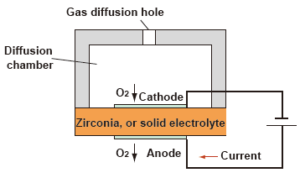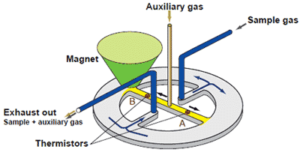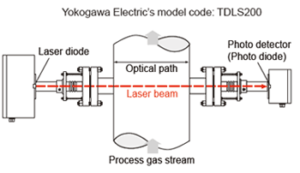Because each oxygen analyzer measurement method has its advantages and disadvantages, it is important to choose an oxygen analyzer to suit your method application and use.
An overview of each measurement method and their advantages and disadvantages are described below.
(1) Zirconia measurement system:
Concentration tank system, high conductivity temperature of solid electrolyte oxygen ions such as zirconia.
As shown in the figure, when the platinum electrode is attached to both when porous, the side heating of the zirconia element and the gas oxygen concentration of different parts are brought into contact with the corresponding surface. The zirconia is an oxygen concentration tank. This phenomenon causes an electromotive force to be generated between the two electrodes, and the proportional oxygen concentration is determined according to the Nernst equation.

Advantage: Can be installed directly in the combustion process, such as boiler flue and fast loop without sampling system.
Disadvantage: If the sample gas contains a flammable gas, it can completely burn the measuring cell.
(2) Zirconia type measurement system: limited current type
As shown in the figure below, if the flow of oxygen enters the cathode of the zirconia, the elements heated to high temperature are limited, and there appears a region where the current becomes uniform when the applied voltage increases. This limited current is proportional to oxygen.

Advantage: Capable of measuring trace oxygen concentration. Calibration required in air.
Disadvantages: If the sample gas contains flammable gases, measurement errors will occur.
The presence of dust causes the gas diffusion holes on the cathode side to become blocked; a filter must be installed in the previous stage.
(3) Magnetic measurement system: paramagnetic system
This is one of the methods using oxygen paramagnetism. When the sample gas contains oxygen, the oxygen is sucked into the magnetic field, thereby reducing the flow rate of the auxiliary gas in the gas flow B. The difference in flow velocity between the two gas streams A and B caused by the effect of the flow restriction in the gas stream B is proportional to the oxygen concentration of the sample gas. The flow rate is determined by the thermistor and converted into an electrical signal, and the difference is calculated as the oxygen signal.

Advantages: 1. Capable of measuring flammable gas mixtures that zirconia oxygen analyzer cannot measure.
2. Because no sensor is in contact with the sample gas in the detection section, the paramagnetic system can also measure corrosive gases.
3. In the magnetic type, the paramagnetic system provides faster response time than other systems.
4. In the magnetic type, the paramagnetic system is more resistant to vibration or shock than other systems.
Disadvantage: Need a sampling unit that corresponds to the characteristics of the sample gas or application.
(4) Optical type: tunable diode laser measurement system
The measurement of a tunable diode laser (or TDL) is based on the absorption spectrum. The true peak analyzer is a TDL system that works by measuring the amount of laser light absorption (loss) in the gas being measured. In its simplest form, a TDL analyzer consists of a laser that generates infrared light, focuses the laser through the gas to be measured, then reaches the detector, the detector, and the electronics that control the laser and converts the detector signal into a signal that represents the gas concentration .

Gas molecules absorb light of a specific color and are called absorption lines. This absorption follows Beers’ law.
The TDL analyzer is an effective infrared analyzer that complies with the Bill-Lambert law.
I = Io e-E G L
I am the intensity of the absorbed radiation,
I0 is the initial radiation intensity,
e is the extinction coefficient,
g is the gas concentration,
L is the path length of the measurement area.
Advantages: 1. It can measure a large amount of near-infrared absorption gas in difficult process applications.
2. The ability to measure under very high temperature, high pressure and difficult conditions (corrosive, aggressive, high particle service)
3. Most applications are measured on site, reducing installation and maintenance costs.
Disadvantages: flange installation is necessary on both sides of the process
(5) Electrochemical type: primary battery type
If oxygen is dissolved in an electrolytic solution in which an anode (base metal) and a cathode (noble metal) are adjacent to each other through a separator, a current proportional to the amount of dissolved oxygen is generated. The amount of oxygen passing through the diaphragm is proportional to the partial pressure of oxygen in the sample gas.
Advantages: 1. The detection system can be made very compact; this measurement system has a portable or transportable form.
2. Relatively cheap compared to oxygen analyzers of other measurement systems.
Cons: The solution is limited. Because the primary battery is an oxygen battery, the primary battery deteriorates even if it is not used. Generally, it should be replaced once a year.
